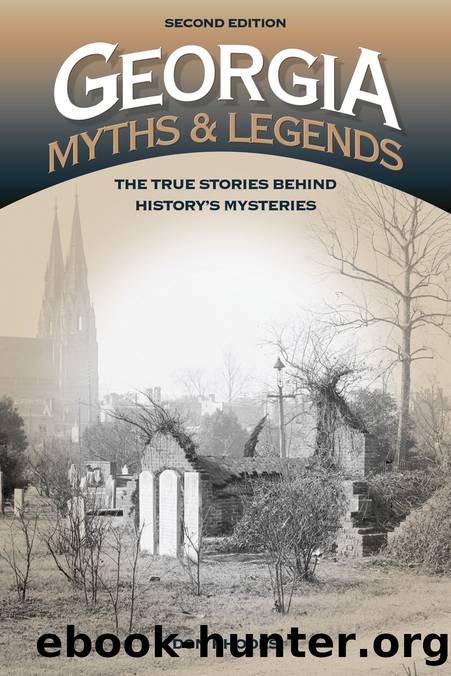Georgia Myths and Legends by Rhodes Don;

Author:Rhodes, Don;
Language: eng
Format: epub
ISBN: 9781493015993
Publisher: Globe Pequot
Published: 2015-08-11T00:00:00+00:00
C H A P T E R 1 0
AMERICAâS FIRST WONDER WOMAN
In the Victorian era, the prevailing images of women were stay-at-home mothers who were weak, helpless creatures. Men were supposed to be their familyâs breadwinners and a strong protector who engaged in manly, muscular activities.
Then, in the late 1800s, along came a buxom teenager from a small Georgia town who could throw men around a stage and exceed them in other public exhibitions of physical strength. Instead of being outraged, the men and women of America loved her and packed the largest theaters across the nation to see this amazing young woman, who was billed as âthe Georgia Wonder.â
Lula Hurst (commonly called Lulu in media about her life) was born in 1869 in rural Polk County, Georgia, near the Alabama state line. Her childhood years apparently were as normal as any other girl until the night of September 18, 1883, following a severe electrical storm.
Reportedly, the fourteen-year-old Lula and her family heard unexplained quick, muffled, popping sounds. After that Lula suddenly had miraculous physical powers. She was able to move objects at will and could cause rapping sounds on tables in response to her questions: one rap for âyesâ and two raps for âno.â Neighbors who began hearing of her remarkable new powers flocked to the Hurst farmhouse. There they found that the teenager could also drag strong men holding walking canes, umbrellas, or billiard cue sticks, despite the fact that she weighed only about 120 pounds and stood five feet six-and-a-half inches tall.
Within months, she had attracted the attention of Paul Atkinson of Madison, Georgia (halfway between Atlanta and Augusta), who became her manager and husband. Henry W. Grady, the famous publisher and editor of the Atlanta Constitution, also became fascinated by her. Grady assigned his top reporter, Josiah Carter, to cover her exploits. And just like wildfire, the news about the young woman dubbed âthe Georgia Wonderâ began to spread rapidly across the nation.
In 1884, during her first full year of performing, she became the toast of New York City with a series of shows at Wallackâs Theater in Manhattan. The New York Times, however, was less than impressed, pointing out that her adoring fans did not seem to care if her âpowersâ were actually due to her ability to place men in physical positions where they were off balance or where they could be influenced by mental suggestions. In fact, on July 12 the Times stated that her stage act âonly proves the philosopher who said that the public likes to be fooled.â Nevertheless, the newspaper conceded that the Georgia Wonder was a powerful force to behold as far as her stage charisma and abilities to charm an audience:
Galleries, balconies, orchestra chairs, boxes and aisles were crowded, and the rest of the populace were jammed at the doors and climbing up each otherâs backs in frantic efforts to catch a glimpse of the stage. It was an audience for the most part that came to be
Download
This site does not store any files on its server. We only index and link to content provided by other sites. Please contact the content providers to delete copyright contents if any and email us, we'll remove relevant links or contents immediately.
Cecilia; Or, Memoirs of an Heiress — Volume 1 by Fanny Burney(32078)
Cecilia; Or, Memoirs of an Heiress — Volume 3 by Fanny Burney(31470)
Cecilia; Or, Memoirs of an Heiress — Volume 2 by Fanny Burney(31420)
The Great Music City by Andrea Baker(30797)
We're Going to Need More Wine by Gabrielle Union(18645)
All the Missing Girls by Megan Miranda(14798)
Pimp by Iceberg Slim(13803)
Bombshells: Glamour Girls of a Lifetime by Sullivan Steve(13701)
Fifty Shades Freed by E L James(12927)
Talking to Strangers by Malcolm Gladwell(12889)
Norse Mythology by Gaiman Neil(12862)
For the Love of Europe by Rick Steves(11564)
Crazy Rich Asians by Kevin Kwan(8901)
Mindhunter: Inside the FBI's Elite Serial Crime Unit by John E. Douglas & Mark Olshaker(8725)
The Lost Art of Listening by Michael P. Nichols(7170)
Enlightenment Now: The Case for Reason, Science, Humanism, and Progress by Steven Pinker(6881)
The Four Agreements by Don Miguel Ruiz(6328)
Bad Blood by John Carreyrou(6286)
Weapons of Math Destruction by Cathy O'Neil(5852)
